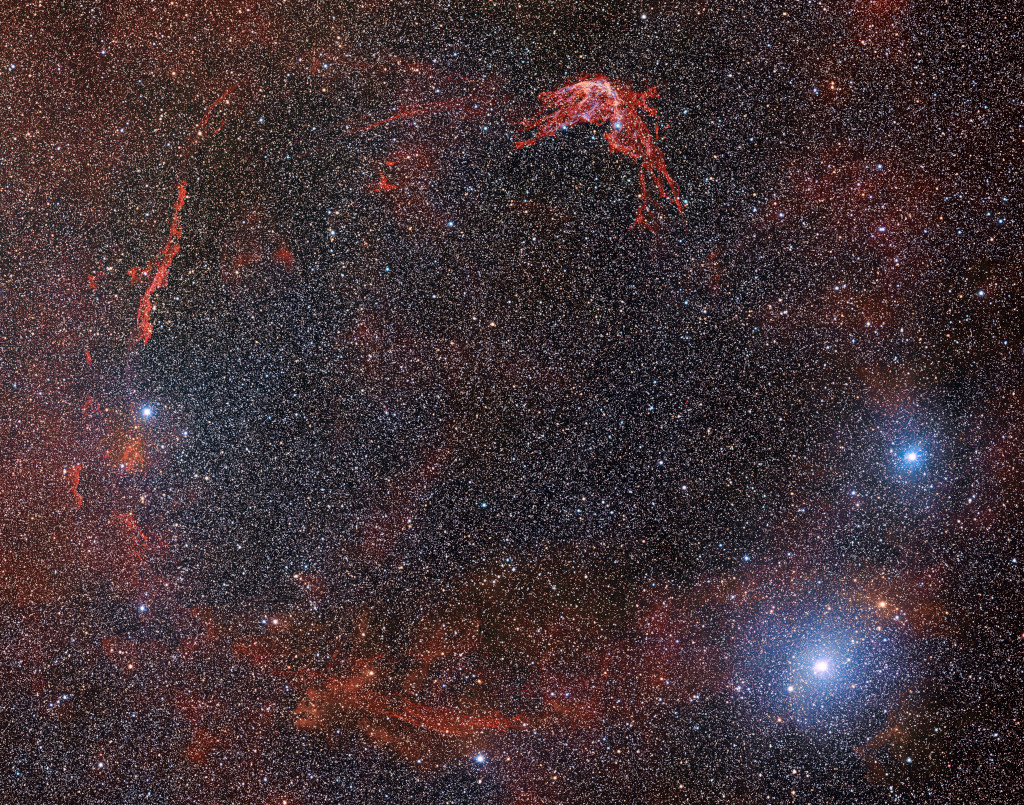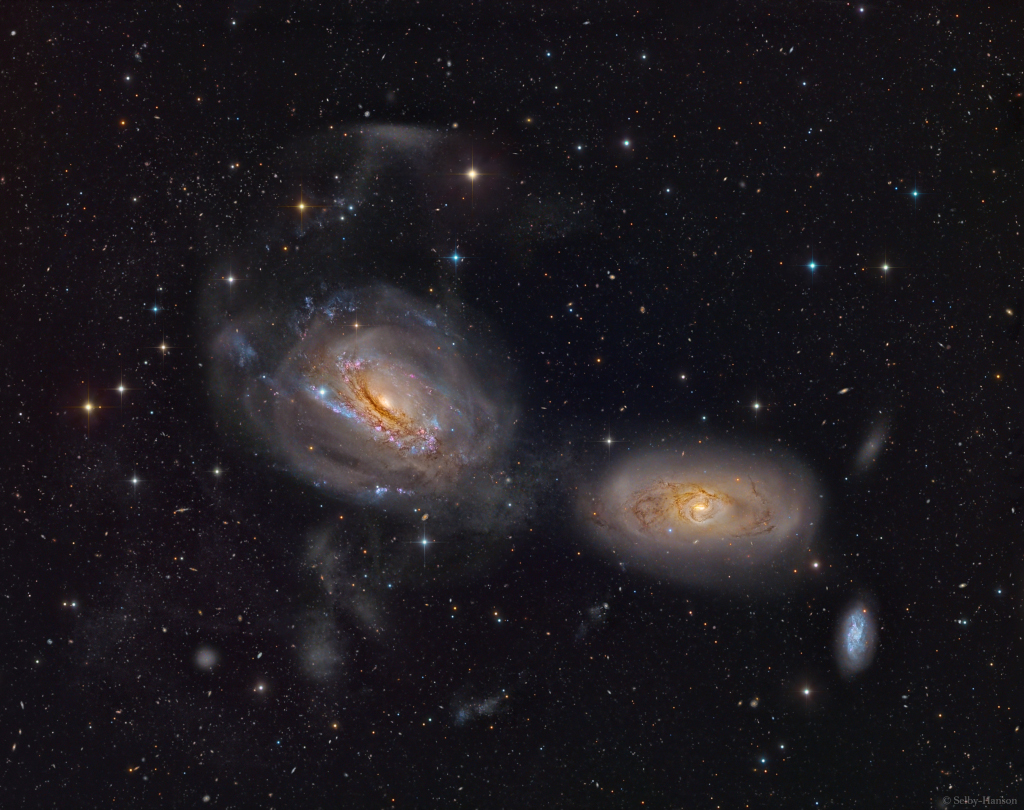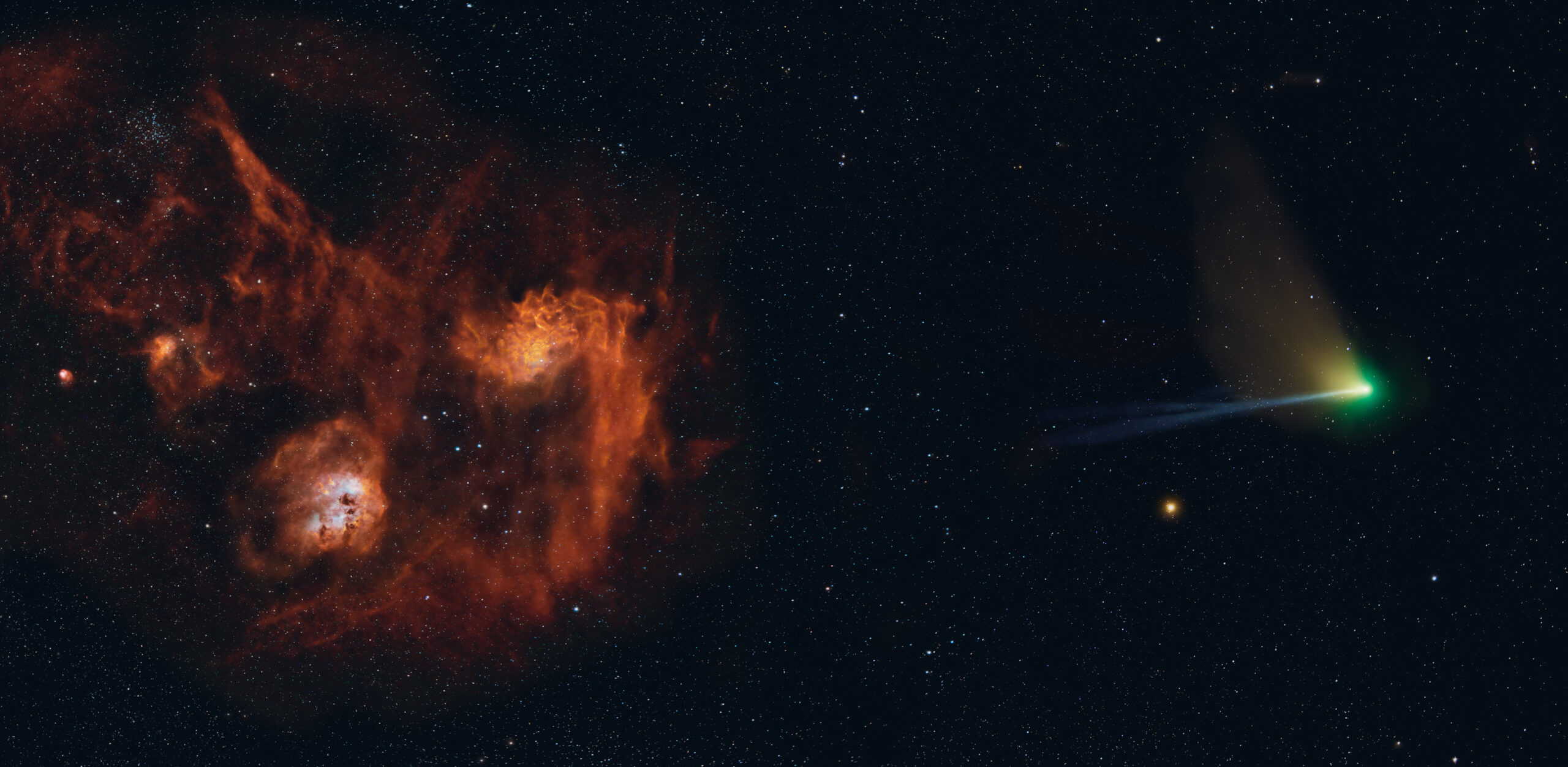Blog
In 185 AD, Chinese astronomers recorded the appearance of a new star in the Nanmen asterism. That part of the sky is identified with Alpha and Beta Centauri on modern star charts. The new star was visible to the naked-eye for months, and is now thought to be the earliest recorded supernova. This deep telescopic view reveals the wispy outlines of emission nebula RCW 86, just visible against the starry background,understood to be the remnant of that stellar explosion. Captured by the wide-field Dark Energy Camera operating at Cerro Tololo Inter-American Observatory in Chile, the image traces the full extent of a ragged shell of gas ionized by the still expanding shock wave. Space-based images indicate an abundance of the element iron in RCW 86 and the absence of a neutron star or pulsar within the remnant, suggesting that the original supernova was Type Ia. Unlike the core collapse supernova explosion of a massive star, a Type Ia supernova is a thermonuclear detonation on a white dwarf star that accretes material from a companion in a binary star system. Near the plane of our Milky Way galaxy and larger than the full moon on the sky this supernova remnant is too faint to be seen by eye though. RCW 86 is some 8,000 light-years distant and around 100 light-years across.

Willie Chambers (born March 3, 1938) is a singer, guitarist, and former member of The Chambers Brothers, a rock band in the 1960s with hits “In The Midnight Hour“, “I Can’t Turn You Loose“, and “Time Has Come Today“. He continues to be a regular attraction at various venues in Los Angeles and further afield.
Along with brothers Lester, Joe and George, Willie was a founding member of The Chambers Brothers and stayed with them through their evolution which included the addition of drummer Brian Keenan in 1965 and the group’s eventual breakup. He sang lead on one of their hits, a cover of Wilson Pickett‘s “In The Midnight Hour“. He also co-wrote their biggest hit “Time Has Come Today” with his brother Joe. He would later work as a session musician. More recently, he has become more active and has collaborated with artists such as Louis Metoyer. He has also been involved with Australian born artists such as Jessie Sparks and singer Stephen Rowe, appearing in his “Restless Soul” video.
more...Robyn Rowan Hitchcock (born 3 March 1953) is an English singer-songwriter and guitarist. While primarily a vocalist and guitarist, he also plays harmonica, piano, and bass guitar. After leading the Soft Boys in the late 1970s and releasing the influential Underwater Moonlight, Hitchcock launched a prolific solo career. His musical and lyrical styles have been influenced by Bob Dylan, John Lennon, Syd Barrett, Captain Beefheart, Martin Carthy, Lou Reed, Roger McGuinn and Bryan Ferry.
more...James Emory Garrison (March 3, 1934 – April 7, 1976) was an American jazz double bassist. He is best remembered for his association with John Coltrane from 1961 to 1967.
Garrison was born in Miami, Florida and moved to Philadelphia when he was 10, where he learned to play bass during his senior year of high school. Garrison came of age in the 1950s Philadelphia jazz scene, which included fellow bassists Reggie Workman and Henry Grimes, pianist McCoy Tyner and trumpeter Lee Morgan. Between 1957 and 1962, Garrison played and recorded with trumpeter Kenny Dorham; clarinetist Tony Scott; drummer Philly Joe Jones; and saxophonists Bill Barron, Lee Konitz, and Jackie McLean, as well as Curtis Fuller, Benny Golson, Lennie Tristano, and Pharoah Sanders, among others. In 1961, he recorded with Ornette Coleman, appearing on Coleman’s albums Ornette on Tenor and The Art of the Improvisers. He also worked with Walter Bishop, Jr. and Cal Massey during the early years of his career. Jimmy Garrison died of lung cancer on April 7, 1976.
more...Arthel Lane “Doc” Watson (March 3, 1923 – May 29, 2012) was an American guitarist, songwriter, and singer of bluegrass, folk, country, blues, and gospel music. Watson won seven Grammy awards as well as a Grammy Lifetime Achievement Award. Watson’s fingerstyle and flatpicking skills, as well as his knowledge of traditional American music, were highly regarded. Blind from a young age, he performed publicly both in a dance band and solo, as well as for over 15 years with his son, guitarist Merle Watson, until Merle’s death in 1985 in an accident on the family farm.
Watson was born in Deep Gap, North Carolina. According to Watson on his three-CD biographical recording Legacy, he got the nickname “Doc” during a live radio broadcast when the announcer remarked that his given name Arthel was odd and he needed an easy nickname. A fan in the crowd shouted “Call him Doc!”, presumably in reference to the literary character Sherlock Holmes‘s companion, Doctor Watson. The name stuck.
more...
“Taranto” is a flamenco style whose origin is in Almería. It derives from the “taranta”, but it follows a rhythm. That makes possible to dance it, in the same way as “zambra mora”. “Taranto” comes from the mining area of Almeria. First singer this style was Pedro Morato but it’s important to quote “El Cabogatero” (1810-1880) and “El Ciego de la Playa” (born around 1840). We must also mention Juan Diaz Abad “Chilares”, born in 1868 in Zapillo, Almeria. “Taranto” is included in “cantes mineros” (fandango, taranto and taranta) and was developed in Almeria, in flamenco evenings, between the 19th and 20th centuries, in three cafes: “Frailito” (Plaza de Santo Domingo), “España” (C/Sebastián Perez, today General Rada), and “Lyon de Oro”.
Flamenco club “El Taranto” is responsible for maintaining this tradition. Regarding the dance, Carmen Amaya is considered as the mother of “Taranto”. “Taranto” was also related to styles of the region of Murcia, whose link was mining lifestyle and singers as El Morato and Chilares, who lived in Cartagena and Almeria. Rojo el Alpargatero lived in Almeria most of his life. There were also influences with Jaén, Linares and La Carolina. The “taranteros” and miners were together with the most famous singers from Jaen such as Basilio, Los Heredia, el Bacalao, Cabrerillo, el Tonto Linares. The bond was the mining railway between Linares and Almeria. There were quite flamenco’s influences between Almería and Málaga. In 1881, the great singer La Rubia de Málaga was hired by the Almería casino. Her stay there would explain that the singing of “El Ciego de la Playa” influenced to the malagueña of “El Canario”, lover of La Rubia de Málaga. It was also learned by Antonio Chacón when he went to Almería to know its flamenco singings.
more...
Spiral galaxy NGC 3169 looks to be unraveling like a ball of cosmic yarn. It lies some 70 million light-years away, south of bright star Regulus toward the faint constellation Sextans. Wound up spiral arms are pulled out into sweeping tidal tails as NGC 3169 (left) and neighboring NGC 3166 interact gravitationally. Eventually the galaxies will merge into one, a common fate even for bright galaxies in the local universe. Drawn out stellar arcs and plumes are clear indications of the ongoing gravitational interactions across the deep and colorful galaxy group photo. The telescopic frame spans about 20 arc minutes or about 400,000 light-years at the group’s estimated distance, and includes smaller, bluish NGC 3165 at the right. NGC 3169 is also known to shine across the spectrum from radio to X-rays, harboring an active galactic nucleus that is the site of a supermassive black hole.

Lewis Allan Reed (March 2, 1942 – October 27, 2013) was an American musician, songwriter, and poet. He was the guitarist, singer, and principal songwriter for the rock band the Velvet Undergroundand had a solo career that spanned five decades. Although not commercially successful during its existence, the Velvet Underground became regarded as one of the most influential bands in the history of underground and alternative rock music. Reed’s distinctive deadpan voice, poetic and transgressive lyrics, and experimental guitar playing were trademarks throughout his long career.
Having played guitar and sung in doo-wop groups in high school, Reed studied poetry at Syracuse University under Delmore Schwartz, and had served as a radio DJ, hosting a late-night avant garde music program while at college. After graduating from Syracuse, he went to work for Pickwick Recordsin New York City, a low-budget record company that specialized in sound-alike recordings, as a songwriter and session musician. A fellow session player at Pickwick was John Cale; together with Sterling Morrison and Angus MacLise, they would form the Velvet Underground in 1965. After building a reputation on the avant garde music scene, they gained the attention of Andy Warhol, who became the band’s manager; they in turn became something of a fixture at The Factory, Warhol’s art studio, and served as his “house band” for various projects. The band released their first album, now with drummer Moe Tucker and featuring German singer Nico, in 1967, and parted ways with Warhol shortly thereafter. Following several lineup changes and three more little-heard albums, Reed quit the band in 1970.
more...Larry Eugene Carlton (born March 2, 1948) is an American guitarist who built his career as a studio musician in the 1970s and 1980s for acts such as Steely Dan and Joni Mitchell. He has participated in thousands of recording sessions, recorded on hundreds of albums in many genres, including more than 100 gold records, as well as for television and movies. He has been a member of the jazz fusion group the Crusaders, the smooth jazz band Fourplay, and has maintained a long solo career.
Carlton was born in Torrance, California, United States, and at the age of six began guitar lessons. His interest in jazz came from hearing guitarist Joe Pass on the radio, after which he moved on to jazz guitarists Barney Kessel and Wes Montgomery, and blues guitarist B.B. King. He went to junior college and Long Beach State College while playing professionally at clubs in Los Angeles.
more...Edward F. Davis (March 2, 1922 – November 3, 1986), known professionally as Eddie “Lockjaw” Davis, was an American jazz tenor saxophonist. It is unclear how he acquired the moniker “Lockjaw” (later shortened in “Jaws”): it is either said that it came from the title of a tune or from his way of biting hard on the saxophone mouthpiece. Other theories have been put forward.
Davis played with Cootie Williams, Lucky Millinder, Andy Kirk, Eddie Bonnemère, Louis Armstrong, and Count Basie, as well as leading his own bands and making many recordings as a leader. He played in the swing, bop, hard bop, Latin jazz, and soul jazz genres. Some of his recordings from the 1940s also could be classified as rhythm and blues.
more...Papa Lightfoot, also known as Papa George Lightfoot (March 2, 1924 – November 28, 1971), born Alexander Lightfoot, was an American blues singer and harmonica player.
Born in Natchez, Mississippi, Lightfoot recorded several sessions in his late twenties – for Peacock Recordsin 1949 (which were never issued), Sultan Records in 1950, Aladdin Records in 1952, and Imperial Records in 1954. After final singles for Savoy Records in 1955 and Excello Records in 1956, Lightfoot quit recording, still an obscure Southern blues harmonica player.
more...Even though AE Aurigae is named the Flaming Star and the surrounding nebula IC 405 is named the Flaming Star Nebula, and even though the nebula appears to some like a swirling flame, there is no fire. Fire, typically defined as the rapid molecular acquisition of oxygen, happens only when sufficient oxygen is present and is not important in such high-energy, low-oxygen environments such as stars. The bright star AE Aurigae occurs near the center of the Flaming Star Nebula and is so hot it glows blue, emitting light so energetic it knocks electrons away from surrounding gas. When a proton recaptures an electron, light is emitted, as seen in the surrounding emission nebula. Captured here three weeks ago, the Flaming Star Nebula is visible near the composite image’s center, between the red Tadpole Nebula on the left and blue-tailed Comet ZTF on the right. The Flaming Star Nebula lies about 1,500 light years distant, spans about 5 light years, and is visible with a small telescope toward the constellation of the Charioteer (Auriga).

Winston Rodney OD (born 1 March 1945), better known by the stage name Burning Spear, is a Jamaican roots reggae singer-songwriter, vocalist and musician. Burning Spear is a Rastafarian and one of the most influential and long-standing roots artists to emerge from the 1970s.
Winston Rodney was born in Saint Ann’s Bay, Saint Ann, Jamaica. As a young man he listened to the R&B, soul and jazz music transmitted by the US radio stations whose broadcasts reached Jamaica. Curtis Mayfield is cited by Rodney as a major US musical influence along with James Brown.Rodney was deeply influenced as a young man by the views of the political activist Marcus Garvey, especially with regard to the exploration of the themes of Pan-Africanism and self-determination. In 1969, Bob Marley, who was also from Saint Ann, advised Rodney to approach Coxsone Dodd‘s Studio One label after Rodney sought his advice during a casual conversation.
Burning Spear was originally Rodney’s group, named after a military award given by Jomo Kenyatta, the first President of an independent Kenya, and included bass singer Rupert Willington. The duo auditioned for Dodd in 1969 which led to the release of their debut single “Door Peep” (the session also included Cedric Brooks on saxophone). They were then joined by tenor Delroy Hinds. The trio recorded several more singles for Dodd, and two albums, before they moved on to work with Jack Ruby in 1975. Their first recording with Ruby, “Marcus Garvey”, was intended as an exclusive track for Ruby’s Ocho Rios–based Hi-Power sound system, but was released as a single, giving them an immediate hit, and was followed by “Slavery Days”. These recordings featured the backing band The Black Disciples, which included Earl “Chinna” Smith, Valentine Chin, Robbie Shakespeare and Leroy Wallace. The group worked with Ruby on their third album, Marcus Garvey (1975), which was immediately successful and led to a deal with Island Records to give the album a wider release.
more...Ralph Towner (born March 1, 1940) is an American multi-instrumentalist, composer, arranger and bandleader. He plays the twelve-string guitar, classical guitar, piano, synthesizer, percussion, trumpet and French horn.
Towner was born into a musical family in Chehalis, Washington, United States. His mother was a piano teacher and his father a trumpet player. Towner learned to improvise on the piano at the age of three. He began his career as a conservatory-trained classical pianist, attending the University of Oregon from 1958-1963, where he also studied composition with Homer Keller. He studied classical guitar at the Vienna Academy of Music with Karl Scheit from 1963–64 and 1967-68.
He joined world music pioneer Paul Winter‘s “Consort” ensemble in the late 1960s. He first played jazz in New York City in the late 1960s as a pianist and was strongly influenced by the renowned jazz pianist Bill Evans. He began improvising on classical and 12-string guitars in the late 1960s and early 1970s and formed alliances with musicians who had worked with Evans, including flautist Jeremy Steig, bassists Eddie Gómez, Marc Johnson, Gary Peacock, and drummer Jack DeJohnette.
Along with bandmates Paul McCandless, Glen Moore, and Collin Walcott, Towner left the Winter Consort in 1970 to form the group Oregon, which over the course of the 1970s issued a number of influential records mixing folk music, Indian classical forms, and avant-garde jazz-influenced free improvisation. At the same time, Towner began a longstanding relationship with the ECM record label, which has released virtually all of his non-Oregon recordings since his 1973 debut as a leader Trios / Solos.
Towner appeared as a sideman on Weather Report‘s 1972 album I Sing the Body Electric. His 1975 album Solstice, which featured a popular track called “Nimbus”, demonstrated his skill and versatility to the full using a 12-string guitar.
Since the early 1990s, Towner has lived in Italy, first in Palermo and then in Rome.
more...Harry Belafonte (born Harold George Bellanfanti Jr.; March 1, 1927 NY,NY) is an American singer, activist, and actor. As arguably the most successful Jamaican-American pop star, he popularized the Trinbagonian Caribbean musical style with an international audience in the 1950s. His breakthrough album Calypso (1956) was the first million-selling LP by a single artist.
Belafonte is best known for his recordings of “The Banana Boat Song“, with its signature “Day-O” lyric, “Jump in the Line“, and “Jamaica Farewell“. He has recorded and performed in many genres, including blues, folk, gospel, show tunes, and American standards. He has also starred in several films, including Carmen Jones(1954), Island in the Sun (1957), and Odds Against Tomorrow (1959).
Belafonte considered the actor, singer and activist Paul Robeson a mentor, and was a close confidant of Martin Luther King Jr. in the Civil Rights Movement in the 1950s and 1960s. As he later recalled, “Paul Robeson had been my first great formative influence; you might say he gave me my backbone. Martin King was the second; he nourished my soul.”Throughout his career, Belafonte has been an advocate for political and humanitarian causes, such as the Anti-Apartheid Movement and USA for Africa. Since 1987, he has been a UNICEF Goodwill Ambassador. He was a vocal critic of the policies of the George W. Bushpresidential administrations. Belafonte acts as the American Civil Liberties Union celebrity ambassador for juvenile justice issues.
Belafonte has won three Grammy Awards (including a Grammy Lifetime Achievement Award), an Emmy Award, and a Tony Award. In 1989, he received the Kennedy Center Honors. He was awarded the National Medal of Arts in 1994. In 2014, he received the Jean Hersholt Humanitarian Award at the Academy’s 6th Annual Governors Awards and in 2022 was inducted into the Rock and Roll Hall of Fame in the Early Influence category and is the oldest living person to have received the honor.
more...Frédéric François Chopin (born Fryderyk Franciszek Chopin; 1 March 1810 – 17 October 1849) was a Polish composer and virtuoso pianist of the Romantic period, who wrote primarily for solo piano. He has maintained worldwide renown as a leading musician of his era, one whose “poetic genius was based on a professional technique that was without equal in his generation”.[5]
Chopin was born in Żelazowa Wola in the Duchy of Warsaw and grew up in Warsaw, which in 1815 became part of Congress Poland. A child prodigy, he completed his musical education and composed his earlier works in Warsaw before leaving Poland at the age of 20, less than a month before the outbreak of the November 1830 Uprising. At 21, he settled in Paris. Thereafter – in the last 18 years of his life – he gave only 30 public performances, preferring the more intimate atmosphere of the salon. He supported himself by selling his compositions and by giving piano lessons, for which he was in high demand. Chopin formed a friendship with Franz Liszt and was admired by many of his other musical contemporaries, including Robert Schumann.
After a failed engagement to Maria Wodzińska from 1836 to 1837, he maintained an often troubled relationship with the French writer Aurore Dupin (known by her pen name George Sand). A brief and unhappy visit to Mallorcawith Sand in 1838–39 would prove one of his most productive periods of composition. In his final years, he was supported financially by his admirer Jane Stirling, who also arranged for him to visit Scotland in 1848. For most of his life, Chopin was in poor health. He died in Paris in 1849 at the age of 39, probably of pericarditis aggravated by tuberculosis.
All of Chopin’s compositions include the piano. They are mostly for solo piano, though he also wrote two piano concertos, some chamber music, and 19 songs set to Polish lyrics. His piano pieces are technically demanding and expanded the limits of the instrument; his own performances were noted for their nuance and sensitivity. Chopin’s major piano works include mazurkas, waltzes, nocturnes, polonaises, the instrumental ballade (which Chopin created as an instrumental genre), études, impromptus, scherzi, preludes, and sonatas, some published only posthumously. Among the influences on his style of composition were Polish folk music, the classical tradition of J. S. Bach, Mozart, and Schubert, and the atmosphere of the Paris salons, of which he was a frequent guest. His innovations in style, harmony, and musical form, and his association of music with nationalism, were influential throughout and after the late Romantic period.
Chopin’s music, his status as one of music’s earliest celebrities, his indirect association with political insurrection, his high-profile love life, and his early death have made him a leading symbol of the Romantic era. His works remain popular, and he has been the subject of numerous films and biographies of varying historical fidelity. Among his many memorials is the Fryderyk Chopin Institute, which was created by the Parliament of Poland to research and promote his life and works. It hosts the International Chopin Piano Competition, a prestigious competition devoted entirely to his works. On 17 October, after midnight, the physician leaned over him and asked whether he was suffering greatly. “No longer”, he replied. He died a few minutes before two o’clock in the morning. He was 39.
more...More Posts
- Daily Roots with the New Establishment
- The Cosmos with NGC 3324
- Jerry Jeff Walker Day
- Fred Neil Day
- Tommy Flanagan Day
- World Fusion with Nsimbi
- Daily Roots with Jackie Mittoo & Ernest Ranglin
- The MAROONS performing for the National Music Museum
- The Cosmos with M101
- Ry Cooder Day
- Charles Lloyd Day
- Lightnin’ Hopkins Day
- World Music with Cañizares
- Daily Roots with the Jolly Boys
- The Cosmos with M31
- Shirley Scott Day
- Quincy Jones Day
- Georg Philipp Telemann Day
- World Music with John Carty
- Daily Roots with Ooklah the Moc